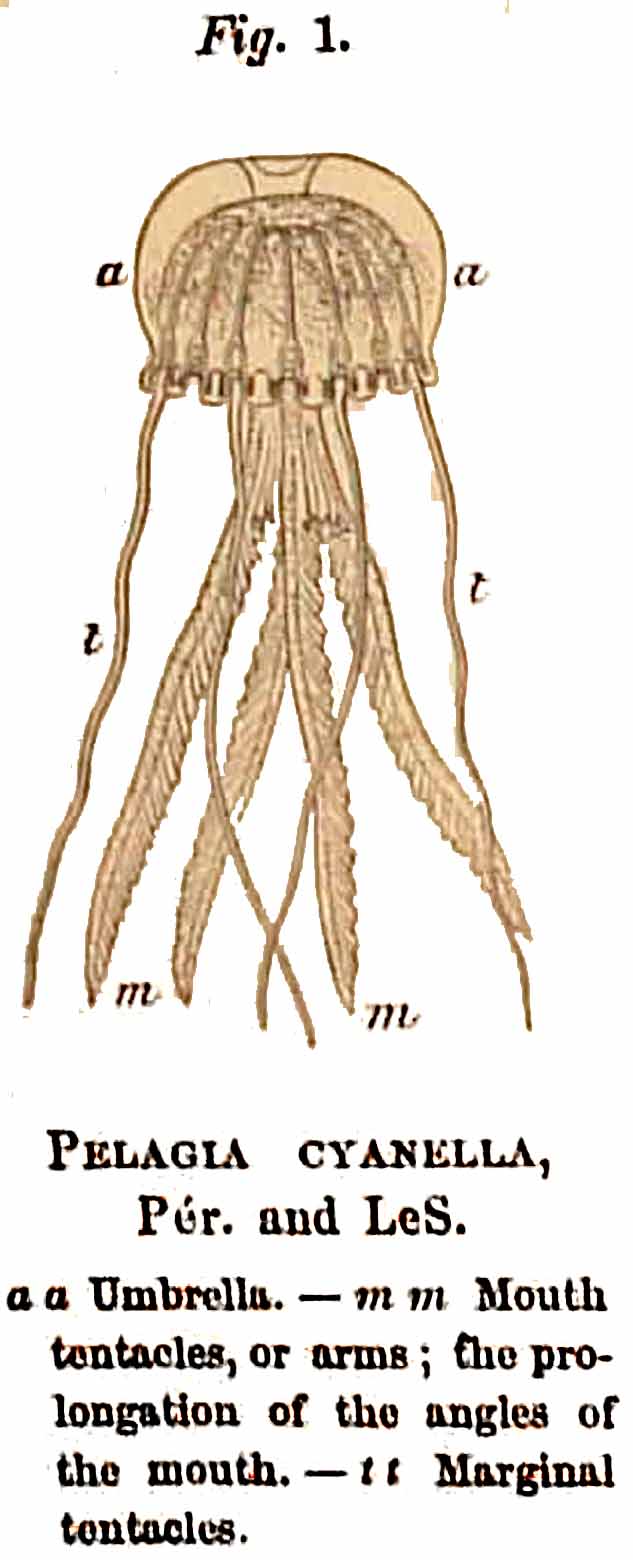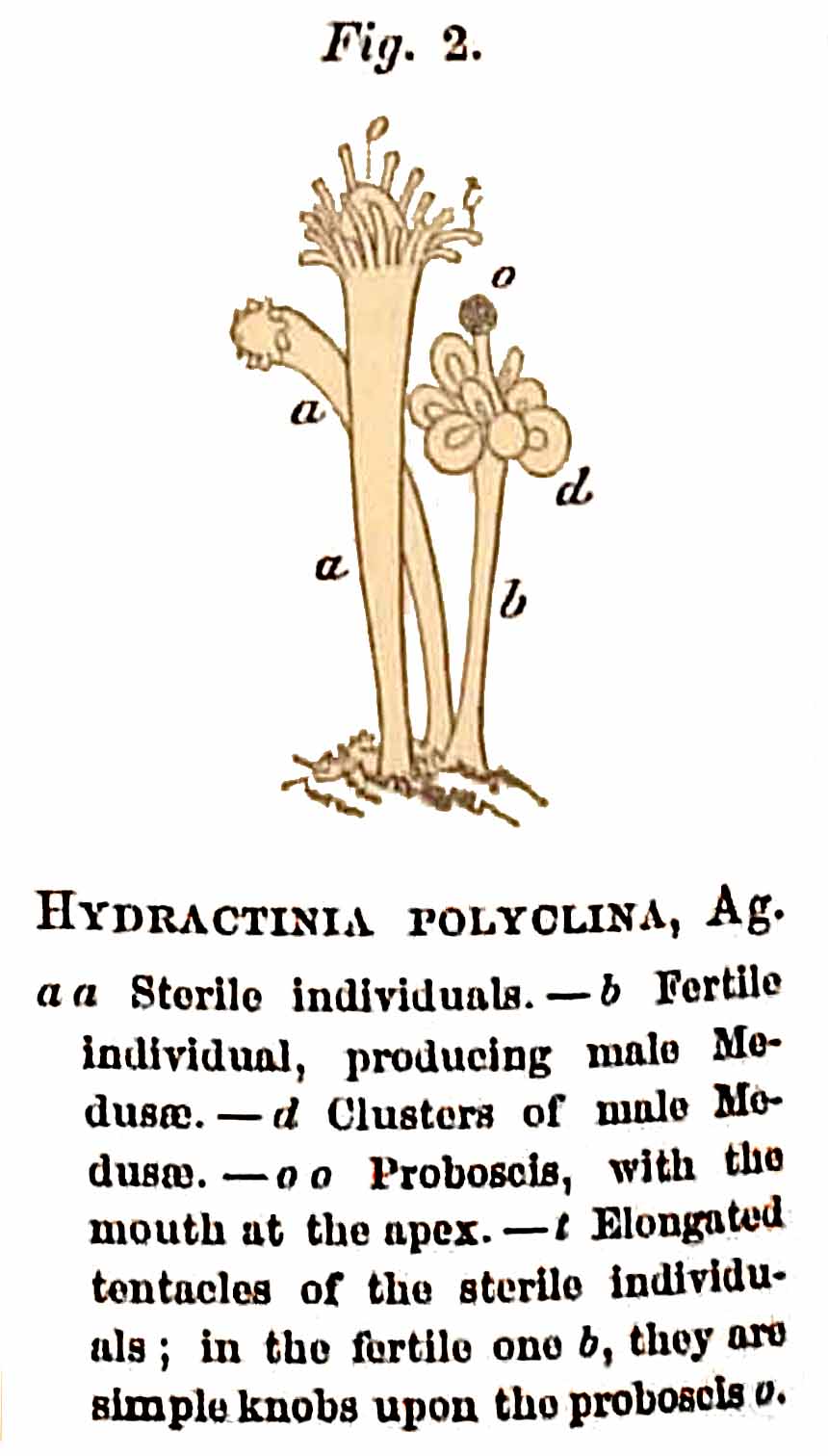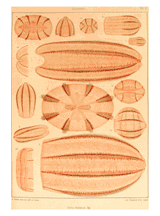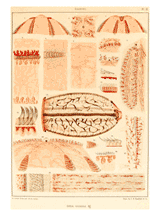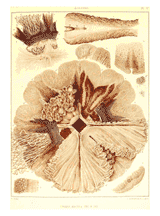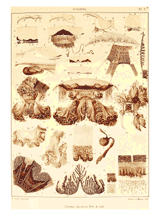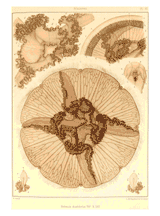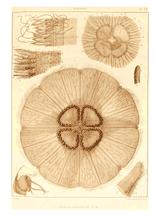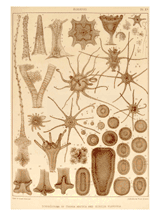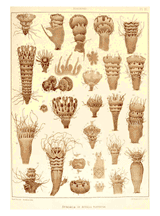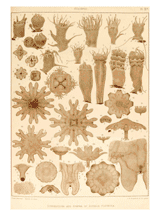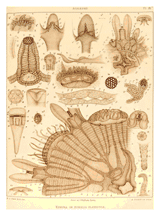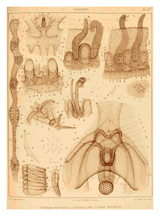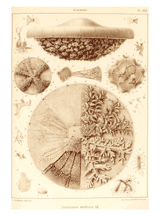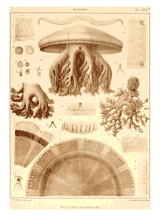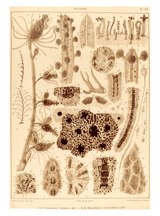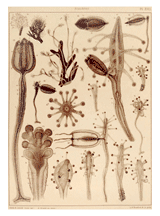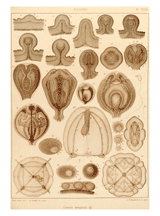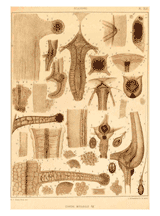


CONTRIBUTIONS
to
THE NATURAL HISTORY
of the
UNITED STATES OF AMERICA
by
LOUIS AGASSIZ
Second Monograph
In Five Parts. - I.
Acalephs in General. - II. Ctenophorae. - III. Discophorae. - IV.
Hydroidae. - V. Homologies of the Radiata.
With Forty-Six Plates
Volume III
BOSTON:
LITTLE, BROWN AND COMPANY.
LONDON:
TRÜBNER & CO.
1860.
301 + 34 pages with 27 plates and 115 woodcuts.
This electronic edition prepared by Dr. David C. Bossard
from original documents in the library holdings of
Dartmouth College, Hanover New Hampshire.
December, 2005.
Copyright © 2005 by David C. Bossard.
NOTE: If the woodcut legends are too small to read easily, you may view
high resolution (400ppi) images at text-figures.
These images are listed by page number and figure number.
Preface v v
vi vii
VOLUME III
CONTENTS.
PART I.
ACALEPHS IN GENERAL
CHAPTER I.
HISTORY OF OUR KNOWLEDGE OF THE
ACALEPHS.
SECTION 1. Period of Aristotle and
the Roman naturalists. 003
004
005
006
007
We find unquestionable evidence in
Aristotle's History of Animals that he knew the Radiates now called
Acalephs by systematic writers, though this name was applied by the
ancient Greeks to the Actiniae as well as to the Acalephae of
zoologists. Pun added nothing to the information of his predecessors,
except a few remarks on the movements of the Medusae. p. 3-7.
[004] The Acalephs include the so-called jelly-fishes or sun-fishes,
and the animals allied to them. ...When we first observe a jelly-fish,
it appears like a moving fleshy mass, seemingly destitute of
organization; next, we may observe its motions, contracting and
expanding, while it floats near the surface of the water. Upon touching
it, we may feel the burning sensation it produces upon the naked hand,
and perhaps perceive also that it has a central opening, a sort of
mouth, through which it introduces its food into the interior.
SECTION 2. The Naturalists of the sixteenth and seventeenth
centuries. 007
008
009
010
011
012
Rondelet is the chief' investigator of
this period; his observations on Medusae disclose the same accuracy of
observation and the saute penetration as his other investigations on
all the natural productions of' the Mediterranean. Gessner deserves to
be studied chiefly on account of his great erudition, and Rondelet for
his deep insight into the relations of animals. p. 7-12.
SECTION 3. The naturalists of the eighteenth century. 013
014
015 016
017
018
Linnaeus gives character and importance
to the study of Natural history, by the publication of the "Systema
Naturae." His pupils and followers explore the world in every
direction. p. 13-18.
SECTION 4. The systematic writers and anatoinists. 018
019 020
021
022
023
024
025
026
027
In the beginning of the nineteenth
century the Acalephs begin to be made the subject of special
investigations. Péron and LeSueur, and, twenty-five years later.
Escherholtz, mark two great epochs in this progress. p. 18-27.
SECTION 5. Embryological researches upon Acalephs. 029
030
031
032
033
034
035
l'he investigations which have led to
the knowledge of the modes of reproduction and growth of the Acalephs
are among the most interesting ever made by naturalists. Sars and
Steenstrupp are most prominent among the discoverers in this field,
and, next to them. Siebold, l)alyell, and Dujardin. p. 28-35.
CHAPTER II.
ACALEPHS AS A CLASS.
SECTION 1. Mode of determining the natural limits of the class. 036
037
038
039
040
The study of the structure of animals,
unless combined with a knowledge of their mode of development and of
their homlogies, is not sufficient to trace the natural limits of the
classes. p. 36-40.
SECTION 2. The different animals referred to the type of
Radiates. 041
042
043
044
045
046
047
048
049
050
051
052
053
054
055
056
057
058
059
060
061
062
063
064
The great diversity of opinions among
naturalists respecting the relations of the lower animals to one
another, has chiefly arisen from a confusion of ideas as to what
constitutes affinity or analogy. p 41-64.
SECTION 3. The classes of Radiata. 064
065
066
067
068 069
070
071
072
There are only three classes among
Radiata, the Polyps, the Acalephs, and the Echinoderms; and these are
characterized by the different modes of execution of the plan of their
type. p. 64-72.
> Acalephs, Polypi, Echinoderms
SECTION 4. Morphology and nomenclature. 073 074
075
076
077
078
079
080
081
082 083
084
085
086
087
Natural range of homologies with
reference to the necessity of introducing new names when new ideas are
discussed, and, if possible, of establishing a connection between the
nomenclature and the objects under consideration. p. 73-87.
SECTION 5. Individuality and specific difference among
Acalephs. 088
089
090
091
092
093
094 095
096
097
098
099
Importance of studying the question of
individuality in connection with that of the limitation of species, p.
88-99. Darwin's views on the origin of species considered from this
side of the question, note p. 99.
SECTION 6. Natural limits of the class of Acalephs. 099
100
101
102
103
104
105
106
107
108
109
110
111
112
113
Though gradually extended farther and
farther, the limits of this class have not yet been sufficiently
expanded
to include all the animals which are now believed to belong to it. p.
99-113.
SECTION 7. Gradation among Acalephs. 113
114
115 116
117
118
119 120
121
122
123
124
Simple as the structure of the Acalephs
is, it is sufficiently complicated readily to point out the relative
rank of the different types belonging to the class. p. 113-124.
SECTION 8. Succession of Acalephs. 125
126
127 128
129
The order of succession of the Acalephs
in geological times can thus far only be traced in one of their types,
the Tabulata, through a long series of formations. p. 125-129.
SECTION 9. classfications of Acalephs. 129
130
131
132
133
134
135
136
137
138
139
140
141
142
143
144
145
146
147
148
149
150
151
152
Before the beginning of this century,
nothing was done towards classifying the Acalephs. Lamarck first unites
together the majority of their representatives; then follow the
classifications of Péron and LeSueur, of Cuvier, of Schweigger,
of Goldfuss, of Chamisso and Eysenhardt, of Latreille, of Eschscholtz,
of DeBlainville, of Oken, of Brandt, of Lesson, of Forbes, of
Lütken, and of Milne-Edwards. More recently embryological
researches have greatly influenced the views of naturalists respecting
the affinities of the Acalephs, and there have appeared new
classifications proposed by Vogt, Kölliker, Leuckart, Gegenbaur,
McCrady, and Huxley. The study of the homologies is likely to modity
these views anew. p. 129-152.
PART
II.
CTENOPHORAE
CHAPTER I.
CTENOPHORAE IN GENERAL
SECTION 1. Structural features of the Ctenophorae in general. 155
156
157
158
159
160
161
162
163
164
165
166
167
168 169
170
171
172
173
Special homologies traced among all
Acalephs, in order to show the peculiarities of the structure of the
Ctenophorae. Natural attitudes and normal position of the Acalephs. p.
155-173.
[`56] Ctenophorae are free Acalephs moving in various ways, their main
axis being generally turned in the direction of their onward motion.
SECTION 2. Subdivisions of Ctenophorae forming suborders. 174
175
176
177
178
179
180
181
182 183
184
185
186
Critical analysis of the systematic
value of the different names under which the different kinds of natural
groups observed among Acalephs have been designated. p. 174-186.
CHAPTER II.
THE NATURAL FAMILIES OF THE
CTENOPHORAE
SECTION 1. Family characters in general among Ctenophorae. 187
188
189
190
As in all classes of the animal
kingdom, the natural families of the Acalephs, and those of the
Ctenophorae in particular, are characterized by particular patterns of
form, determined by structural features bearing upon form. p. 187-190.
SECTION 2. The natural families of the Ctenophorae
Eurystomae. 190
191
192
193
Three families may be distinguished in
this sub-order: the Beroidae proper, the Neseidae, and the Rangiidae.
p. 190-193.
SECTION 3. The natural families of the Ctenophorae Saccatae.
193
194 195
196
197
198
This sub-order embraces also three
natural families: the Mertensidae, the Cydippidae, and the
Callianiridae, p. 193-198; while the Cestidae, p. 198, constitute a
sub-order by themselves. p. 292.
SECTION 4. The natural famillies of the Ctenophorae Lobatae.
199
200
201
202
Five families may now be distinguished
in this sub-order: the Euramphaeidae, the Bolinidae, the Mnemiidae, The
Calymmidae, and the Oeyroidae. p. 199-202.
CHAPTER III.
NORTH AMERICAN CTENOPHORAE
SECTION 1. The genus Pleurobrachia and its species. 203
204
205
206
207
208
209
210
211
212
213
214
215 216
217
218
219 220
221
222
223
224
225
226
227 228
229
230
231
232
233
234
235
236
237
238
239
240
241
242
243
244
245
246
247
248
Natural limits of the genus. Its form
and structure; the bulk of the body consists of gigantic cells; their
arrangement; the locomotive flappers; the circulation of fluids; the
tentacular apparatus; the lasso-cells of the tentacles illustrated by
Prof. H. J. Clark; other structural details. p. 203-248.
SECTION 2. The genus Bolina and its species; with remarks on
allied genera. 249
250
251
252
253
254
255
256
257
258
259
260
261
262
263
264
265
266
267
268 269
Characters of the genus; comparison
with Pleurobrachia ; the ambulaeral tubes and the locomotive flappers
have not the same extent; the whole chymiferous system and its
ramifications differ in different types of Ctenophorae, p. 249-269.
Genus Mnemiopsis, p. 269.
SECTION 3. The genus Idyia and other true Beroids. 270
271
272
273 274
275
276
277
278
279
280
281
282 283
284
285
286
287
288
Differenee between Beroe and Idyia as
genera. The species belonging to each. Description of the species most
common along our coast. Its structure, p. 270. Idyopsis, p. 288.
SECTION 4. Tabular view of the Ctenophorae known at present. 289
290
291
292
293
294 295
296
Systematic enumeration of all the
Ctenophorae thus far described, with their principal synonymes, p.
289-296.
SECTION 5.Geographical distribution of the Ctenophorae. 297
298
299
300
301
First attempt to define the faunae of
the sea by the Ctenophorae found in different parts of the world;
distinction between faunae and zoological zones. p. 297-301.
Plate Descriptions 302-327 302
303
304
305
306
307
308
309
310
311
312
313
314
315 316
317
318
319 320
321
322
323
324
325
326
327
PLATES



